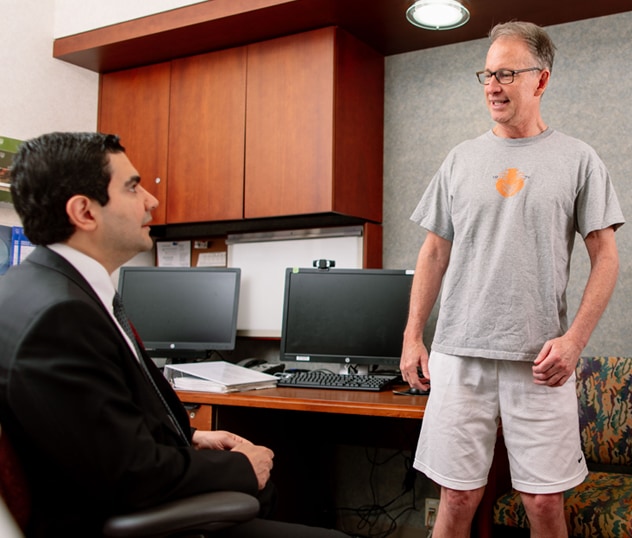June 27, 2020
Following promising phase 1 testing, Mayo Clinic is launching phase 2 of a randomized clinical trial of stem cell treatment for patients with severe spinal cord injury. The clinical trial, known as CELLTOP, involves intrathecal injections of autologous adipose-derived stem cells.
"The field of spinal cord injury has seen advances in recent years, but nothing in the way of a significant paradigm shift. We currently rely on supportive care. Our hope is to alter the course of care for these patients in ways that improve their lives," says Mohamad Bydon, M.D., a neurosurgeon at Mayo Clinic in Rochester, Minnesota.
 Bydon 医生在 CELLTOP I 期试验中检查 1 号患者
Bydon 医生在 CELLTOP I 期试验中检查 1 号患者
The first participant in the phase 1 trial was a superresponder who, after stem cell therapy, saw significant improvements in the function of his upper and lower extremities.
"Not every patient who receives stem cell treatment is going to be a superresponder. Among the 10 participants in our phase 1 study, we had some nonresponders and moderate responders," Dr. Bydon says. "One objective in our future studies is to delineate the optimal treatment protocols and understand why patients respond differently."
In CELLTOP phase 2, 40 patients will be randomized to receive stem cell treatment or best medical management. Patients randomized to the medical management arm will eventually cross over to the stem cell arm.
Study participants must be age 18 or older and have experienced traumatic spinal cord injury within the past year. The spinal cord injuries must be American Spinal Injury Association (ASIA) grade A or B.
Reversing the microenvironment
The initial participant in CELLTOP phase 1 sustained a C3-4 ASIA grade A spinal cord injury. As described in the February 2020 issue of Mayo Clinic Proceedings, the neurological examination at the time of the injury revealed complete loss of motor and sensory function below the level of injury.
After undergoing urgent posterior cervical decompression and fusion, as well as physical and occupational therapy, the patient demonstrated improvement in motor and sensory function. But that progress plateaued six months after the injury.
Stem cells were injected nearly a year after his injury and several months after his improvement had plateaued. Clinical signs of efficacy in both motor and sensory function were observed at three, six, 12 and 18 months following the stem cell injection.
"Our patient also reported a strong improvement with his grip and pinch strength, as well as range of motion for shoulder flexion and abduction," Dr. Bydon says.
Spinal cord injury has a complex pathophysiology. After the primary injury, microenvironmental changes inhibit axonal regeneration. Stem cells can potentially provide trophic support to the injured spinal cord microenvironment by modulating the inflammatory response, increasing vascularization and suppressing cystic change.
"In the phase 2 study, we will begin to learn the characteristics of individuals who respond to the therapy in terms of their age, severity of injury and time since injury," says Anthony J. Windebank, M.D., a neurologist at Mayo's campus in Minnesota and director of the Regenerative Neurobiology Laboratory. "We will also use biomarker studies to learn about the characteristics of responders' cells. The next phase would be studying how we can modify everyone's cells to make them more like the cells of responders."
CELLTOP illustrates Mayo Clinic's commitment to regenerative medicine therapies for neurological care. "Our findings to date will be encouraging to patients with spinal cord injuries," Dr. Bydon says. "We are hopeful about the potential of stem cell therapy to become part of treatment algorithms that improve physical function for patients with these devastating injuries."
For more information
Bydon M, et al. CELLTOP clinical trial: First report from a phase I trial of autologous adipose tissue-derived mesenchymal stem cells in the treatment of paralysis due to traumatic spinal cord injury. Mayo Clinic Proceedings. 2020;95:406.
Regenerative Neurobiology Laboratory: Anthony J. Windebank. Mayo Clinic.